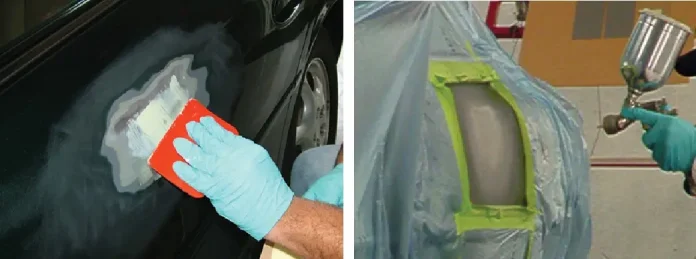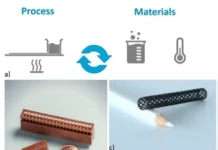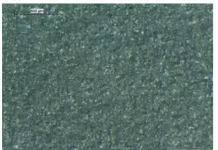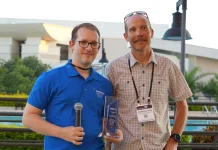By Michael J. Dvorchak, Dvorchak Enterprises LLC
Over the last decade, the automotive refinish industry has been forced to look at new technologies to reduce volatile organic content (VOCs) and hazardous air pollutants (HAPs), while providing a rapid return to service of the consumers’ vehicles. UVA-cured 1K auto refinish primers first were introduced in the mid-1990s. UVA clear coats subsequently were introduced in the late 1990s.
Materials have continued to be developed and pushed to mimic the classic 2K solvent-based polyurethanes (PURs); however, slow acceptance by the auto refinish market over the last two decades is indicative of a market that is difficult to change. RadTech, in conjunction with I-CAR, an industrial training organization for the collision repair professional, developed a web-based training module for UVA cure 1K auto refinishing. Over 900 of these module courses had been purchased from I-CAR by the collision repair professional by 2008. A recent data capture reveals the total number of technicians trained to be more than 3,000.
1K UVA Cure Automotive Refinish History
The following is the historical review of 1K UVA Cure Automotive Refinish and attempts to make it a major technology.
Early attempts to develop a UV refinish clear coat
The earliest paper1 that reviews the use of UV-cure clear coats for auto refinish was focused on the use of a UV Flash lamp (Xe lamp). The idea was that after applying the fully formulated UV clear coat, it would be flashed several times (by the Xe lamp) to activate the photoinitiator (PI) for this dual-cure system. The dual-cure cross-linking of this system was done with a polyol that had acrylate and hydroxyl functionality in combination with a dual-cure cross-linker that possessed acrylate and polyisocyanate functionality. This system essentially was a 2K system. Due to the Xe lamp wavelength occurring around 480 nm, the use of a bis-acyl-phosphine-oxide is specified for this use. Cure was completed by using 10 to 20 flashes at 20°C.
Early patents on UVA cure auto refinish primers
Earliest US patent2 estates (2001) in this technology workspace were developed around UV oligomers that were used with bis-acyl-phosphine-oxide PIs and full-spectrum 250 W iron-doped UV sources. These then were filtered down to only emit in the UVA region. The cure time with this configuration was one minute. The UV was filtered to prevent worker exposure to UVB and UVC wavelength. One issue with this system was the need for a solvent wipe because the surface of the film had become inhibited by oxygen. This surface inhibition issue plagued this technology. Future work led to keeping high levels of oligomers, low levels on acrylates monomers and new developments in UV sources. In addition, the PIs that were used needed to work above the absorption window of the fillers and pigments. The resultant UVA cured primer needed to be sanded immediately after it had cured.
Automotive OEM technical paper on UV auto refinish clear coats
One of the OEMs got in on the evaluation of UV cure clear coating supplied by the OEM paint company3. In the OEM’s evaluation, there was discussion surrounding the need for HALS and UVAs. It was surprising that an OEM would be evaluating UV clear coats so early in the development cycle. The only possible reason for interest at this stage would be the ever-increasing need to evaluate the best technology for the automotive OEM environment. This early evaluation uncovered issues with unacceptable brittleness of the UV cured clear coat technology. It found that the HALS and UVAs slowed this process, but still eventually embrittled to an unacceptable level for an automotive clear coat.
2003 patent application by a paint company on UVA cure clear coats
In 2003, a UV cure paint company filed a patent4 application on the development of a UVA cure clear coat. In this application, references are made to the system being 1K, UVA/UVV and UVA-only curable. The cure time is reported to be four minutes with no gloss reduction or cracking when subjected to weathering via SAEJ1960. This performance was better than what was reported earlier by the automotive OEM during its testing of UVA cure clear coat prototypes.
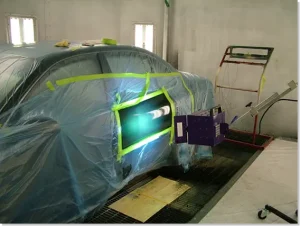 2003 RadTech report on use of UVA cure primer systems in body shops
2003 RadTech report on use of UVA cure primer systems in body shops
A report was prepared in 2003 that reviewed the actual use of UVA primer systems5. This report went into great detail as to why specific body shops were using the technology, including 1) time savings of 25% to 88% on each job; 2) less preparation time; 3) reduction in disposable utensil use; 4) reduced masking; 5) no flash times required between layers; and 6) less waste over a 2K system. Individuals at the four body shops interviewed did not report any downsides to the technology. However, the article stated the need for a UVA auto refinish clear coat.
2006 patent application on dual-cure UV clear coat spot repair
The concept described in this patent application involves the use of a dual-functional oligomer that has acrylate as well as polyisocyanate to develop a spot blender in automotive refinishing with a focus on spot repair.6 This clear coat spot repair is done by applying the coating after preparing the surface and then applying a shortwave infrared radiation for three minutes. Lastly, UVA radiation would be applied at a dose of 4,000 mJ/cm2. At the completion of this curing, the coating surface easily was polishable without defects.
With the abundance of potential technology in the pipeline, it is surprising that it has not further developed into a major technology in the automotive refinishing industry. These facts were the main reason that RadTech pursued I-CAR to help further develop this market.
Grassroots RadTech Initiative with I-CAR
In 2007, co-chairs (Richards and Dvorchak) of the Automotive Focus Group and H & S Autoshot (UVA lamp supplier) formulated an idea to help develop the use of a 1K UVA cured automotive refinish training module with I-CAR. I-CAR is a nonprofit training organization for collision automotive repair. By April 2008, the web-based training module was completed, and users started to take the training.
The I-CAR training module included the following learning objectives for the students:
- Describe RadTech and its relationship with the UV cure industry
- Identify the difference between UV-cure products and two-part products
- Identify safety procedures for working with UV-cure products and UV-cure lamps
- Describe how to properly use UV-cure glazing fillers
- Describe how to properly use UV-cure primer-surfacers
- Describe how to properly use UV-cure clear coats
- Describe how to properly use and maintain UV-cure lamps
- Be able to list the environmental advantages of the UV-cure products
As can be seen in the learning objectives, the I-CAR training module covered all bases surrounding safety, differences between older technology and UV cure, an in-depth review of the technology and an explanation of the environmental advantages of the UV-cure technology.
The goal of the I-CAR training module was to provide an effective method to educate automotive refinish technicians, giving them an easy method to understand the technology and providing a useful tool in their careers. Suppliers of UVA equipment garner an understanding of the needs and potential benefits of the I-CAR education program, as well as a follow-up on developments of new UVA cure sources. Completion of the education allows raw material suppliers to better focus on the needs of and developments for the UVA cure refinish industry, with relevant feedback from the ultimate end user. And UVA cure refinish paint suppliers that complete the I-CAR training modules are provided a focus on this industry that allows them to develop relevant products necessary to succeed in the automotive refinish industry.
The true benefits of a 1K UVA cure automotive coatings
The 1K UVA cure automotive refinishers soon realized the following benefits of this unique technology:
- Reduced material costs: The 1K UVA cure coatings system had a reduced material cost as compared to the conventional 2K refinishing systems due to not having activated material that was not used.
- Reduced disposal costs: Disposal costs of the unused 2K materials were an additional cost savings for the 1K UVA cure automotive refinisher.
Reduced labor costs: Reduced labor costs also were realized in the time and error factors of mixing and time-limiting pot life. - Elimination of spray gun cleaning: Spray gun cleaning was eliminated since there was no pot life – the 1K UVA refinish material could remain in the gun. It was realized early on that light-shielding materials needed to be used for the cup on the spray gun to prevent premature ambient activation of the 1K UVA refinish material.
- Reduced cure time: The ultimate benefit was the reduced cure time between the 2K and the 1K UVA cure refinish material. Classic 2K primer systems could take up to one hour, while the 1K UVA cure material would cure in two to five minutes. A 1K UVA refinish user reported that this technology was the “best kept secret” in the automotive refinish industry.
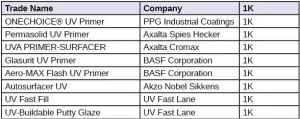
Coatings Suppliers of 1K UVA Cure Automotive Refinish Putty, Glazes and Primers
In light of this information, it is important to review which UVA cure putty, glazes and primers exist in the market today. Table 1 shows a list of these products and major manufacturers.
This is not an exhaustive list of products. An exhaustive list of all the current products will be a subject of a future article. These products are all designed to work as a putty, filler and or primer.
A 1K UVA clear coat has been introduced to the market, but it currently is difficult to find such products. Technical papers have been written on the 1K UVA Clear Coat technology and have shown some of the performance considerations that are needed to meet the automotive refinish industry performance requirements.

Today’s UVA Cure Sources for the 1K UVA Cure Automotive Refinish Market
With the I-CAR program, there was a need for a UV cure source. Today, the potential UV sources available for automotive refinish are listed in Table 2. This list is not complete but will be developed further in a future technical paper.
Current RadTech Automotive Refinish Project
The RadTech Automotive Focus Group has developed a program with the Ford Motor Company to work toward and answer questions about the development of a 1K UVA clear coat. The study is intended to follow up on a 2003 study that included an in-depth chemical and physical analysis on what was, at the time, state-of-the-art UV-curable clearcoats to determine if they performed well enough for the automotive industry. Cracking/embrittlement during service proved to be significant issue of the UVA clear coat materials that were evaluated.
The latest Ford Motor Company study is evaluating seven clear coats submitted by UV cure material suppliers. These test results will be presented at a future RadTech conference.7
I-CAR training module in 2022
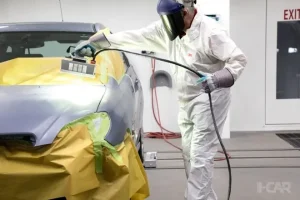 Currently, the I-CAR training module has been training automotive refinish technicians for over 14 years. Several years ago, I-CAR wanted to update the sponsored RadTech course. I-CAR turned to the paint industry and revised the current course, independent of RadTech, yet it used the core RadTech material. At this point in time, the course needs to be revised to update additional 1K UVA coatings and UV sources. The new Industrial Finishes Focus Group will take on the development of the revised I-CAR training module supporting both UV coatings and UV lamp suppliers.
Currently, the I-CAR training module has been training automotive refinish technicians for over 14 years. Several years ago, I-CAR wanted to update the sponsored RadTech course. I-CAR turned to the paint industry and revised the current course, independent of RadTech, yet it used the core RadTech material. At this point in time, the course needs to be revised to update additional 1K UVA coatings and UV sources. The new Industrial Finishes Focus Group will take on the development of the revised I-CAR training module supporting both UV coatings and UV lamp suppliers.
Future outlook for the UVA curable refinish market
In September 2003, the RadTech organization sponsored an event termed “Driving Change,”8 which was attended by over 130 people. The purpose of the event was to bring together all the knowledge that was available on UV cure and automotive exterior coatings technologies. The attendees included OEMs, OEM paint companies, raw material suppliers, academia and many other cross-functional specialties in the coating business. The outcome of this conference predicted a bright future for UV technology and the automotive industry.
However, the future of this market really is tied to the introduction of a 1K UVA cure clear coat. Attempts to develop and introduce such products have not been met with a lot of success. In 2007, the RadTech Transportation Focus Group developed a web-based training seminar in conjunction with I-CAR. Since its inception, over 3,000 professional body repair technicians have paid for and taken this course. This kind of data from the grassroot level tells us that this definitely is a developing market and that professional auto body technicians are interested in UV technology. However, even with this interesting data, it still isn’t clear why this technology has not developed further into the auto refinishing market. Only major changes in the refinish market will see the evolution and development of the 1K UVA refinish technology.
Michael J. Dvorchak is technical director of Dvorchak Enterprises LLC. He can be reached at 412.996.5225, via email at MikeD@isharkskin.com or on the web at DvorchakEnterprisesLLC.com.
References
- K. Magg, et al., Progress in Organic Coatings, 40 (2000) 93-97
- D. Fenn, et al., US 6,838,177 Mar. 27, 2003
- M. Nichols, et al., RadTech Report, Nov/Dec 2001
- D. Braun, et al., US 2005/0095371 May 5, 2005
- D. Maloney, RadTech Report, Nov/Dec 2003
- B. Lettmann, et al., US 7,683,105 Mar. 23, 2010
- C. Seubert, UV+EB Technology, April 2019
- Driving Change Event at the University of Akron, Sept. 2003


